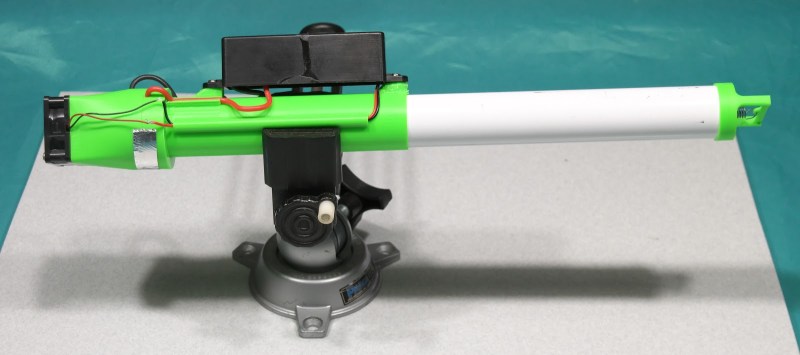One lesson we can learn from the Vietnam War documentary Apocalypse Now is that only crazy people like terrible smells just for fun. Surely Lt. Col. Kilgore would appreciate the smell of 3D printers as well, but for those among us who are a little less insane, we might want a way to eliminate the weird (and not particularly healthy) smell of melting ABS plastic.
While a simple solution would be a large fume hood or a filter to prevent inhaling the fumes, there are more elegant solutions to this problem. [Mark]’s latest project uses an electrostatic precipitator (ESP) to remove the volatile plastic particles from the air. Essentially it is a wire with a strong voltage applied to it enclosed in a vessel of some sort. The voltage charges particles, which then travel to a collecting electrode. Commercial offerings also include an X-ray generator to help clean the air, but [Mark] found this to be prohibitively expensive.
The ESP is built into a small tube through with the air can flow, and the entire device itself is housed in the printing enclosure. The pictures show the corona discharge in the device, and [Mark] plans to test it over the next few months to determine its effectiveness. He does note, however, that the electrostatic discharge creates ozone, which has its own set of problems, so he recommends against building one on your own. Ozone at least still smells like victory.
















What’s a strong voltage?
High voltage – high number before that ‘V’ letter, strong voltage – many volts at once. Or maybe strong voltage – many amps? It was probably a typo.
Strange that this got posted on hack-a-day.
I abandoned this project because as I was working on it I kept searching and reading papers on emissions from printers and using ozone to break down VOCs, etc., and it became apparent that the chemistry is very complex. Using this sort of thing is just as likely to make the problems worse as it is to make them better. Without all the instrumentation needed to analyze the composition of the air in the printer, there’s no point in doing this.
Also, please note that a pleasant odor or an absence of odor does not mean there isn’t anything hazardous present.
Don’t build this one…
Yep, ozone is pretty bad even in low concentrations
Not just that, you have no way of ensuring the hazardous VOCs etc are not being converted into other hazardous compounds plus ozone.
As for HaD publishing it…
Well, we (the readers) are also interested in “what doesn’t work”.
Maybe your work could have been listed under “Fail of the Week”.
…that’s the beautiful part. When wintertime rolls around, the gorillas simply freeze to death.
An attempt was made, and I certainly appreciate the effort and documentation of the attempt. I am glad Hackaday covered it. It might save someone else some time and effort. Too often, we get a “file drawer” effect with fails.
The implication in the hackaday post that your “don’t do this” was essentially “wink wink” was irresponsible on their part.
Thank you for posting about your learning, and I hope hackaday living down to normal expectations for the internet in general doesn’t discourage you from continuing to share failure as well as success.
Bryan, please fix your description to make it clear that this is an abandoned project. It’s very clear that you didn’t even read Mark’s post carefully before pretending to summarize it. Leaving your description in its original state would be negligent.
“He does note, however, that the electrostatic discharge creates ozone, which has its own set of problems, so he recommends against building one on your own.”
There’s no “wink wink” here, and I also wouldn’t rule out the possibility of others being able to handle ozone safely while still being interested in this idea for other purposes.
“… the Vietnam War documentary Apocalypse Now …”.
That movie must have been called a lot of things over it’s long history, but I doubt anybody has ever called it a documentary.
Mockumentary?
B^)
Yes, much better.
I read that and stopped. I saw it in 70mm and 5.1 stereo when it came out. Wow, that was the best movie (visually and audio) I had ever seen/heard. The photography was over the top, and the sound was fantastic. The plot supported the sound. The Doors opening was super, thanks to Robbie’s Krieger’s guitar.
Drop the voltage until you’re not cracking O2 and producing O3.
It will still make the VOCs in the air going through the tube lose their positive charge and drop to the floor.
One of the papers I listed at the end of the blog post found that a combo of low voltage (<8 kV IRIC) and "soft" x-rays was very efficient (100%) at removing nanoparticles. In the same paper he found that high voltage ESP alone was also very efficient, but produced ozone.
I've been looking into soft x-ray sources and it seems it wouldn't be too hard to make one, so I may revisit this project once I manage to get that working. Then I can drop the ESP voltage and eliminate ozone production.
Place an old CRT TV in the room and most particles stick on the CRT.
I use an electrostatic precipitator at work as a smoke eater on 2 Agie Charmilles EDMs, but I must admit, I don’t know if they generate any ozone, or what voltage runs through them.
Has anyone done a working homemade electrostatic precipitator, or is there a good place to find out more about building one? I have been thinking about setting up a paint booth at home and this would be useful if I could find something that worked without choking my house full of ozone